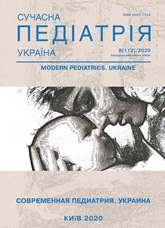Clinical analysis of vital indicators in newborns and infants with surgical pathology with different types of anesthesiological support
Abstract
Congenital defects are more common in newborns and children of the first year of life and require surgical correction in the first hours, days of life. Surgical interventions against the background of serious diseases and malformations can lead to catabolic stress, circulatory and respiratory disorders, metabolism, water-electrolyte, protein and acid-base states, which are reflected in the indicators of vital functions.
Purpose — to conduct a clinical analysis of indicators of vital functions in newborns and infants with congenital surgical pathology with various types of combined anesthesia.
Materials and methods. A retrospective study included 150 newborns and infants with congenital malformations of the surgical profile, depending on the anesthesia (inhalation + regional anesthesia — group І (50 newborns); inhalation + intravenous anesthesia — group ІІ (50 newborns); total intravenous — group III (50 newborns)). The parameters of peripheral and cerebral oximetry, blood pressure, heart rate and respiration were analyzed.
Results. The minimum indicator of cerebral oximetry was noted in the left brain hemisphere of children of the ІІ group — 50.57±16.66, which may be an unfavorable prognostic factor in further recovery and influence on the cognitive functions of the child's brain. Peripheral saturation did not critically decrease at all stages of observation. With the exception of the resulting decrease in the indicator in children of group I compared with group III at the stage of induction into anesthesia (97.79±2.45 versus 98.79±1.63, at p=0.0194, respectively) and at the most painful moment of surgical intervention (96.29±3.47 versus 98.10±2.47, with p=0.0368). In children who received combined intravenous anesthesia with two drugs, there was an increase in mean arterial pressure from the beginning of surgical treatment to the child's recovery after surgery (49.49±10.71; 56.18±8.05, respectively, at p<0.01).
Conclusions. Among the surveyed groups, the most vulnerable to pathological changes in vital function indicators were children for whom anesthetic support was provided by inhalation anesthesia with sevoran with regional anesthesia.
The research was carried out in accordance with the principles of the Helsinki Declaration. The study protocol was approved by the Local Ethics Committee of these Institutes. The informed consent of the patient was obtained for conducting the studies.
References
Alekseeva EA. (2015). Tserebralnaya oksimetriya v sostave monitoringa intraoperatsionnogo perioda i intensivnoy terapii u detey. Avtoref dis kand med nauk: 25. URL: http://medical-diss.com/medicina/tserebralnaya-oksimetriya-v-sostave-monitoringa-intraoperatsionnogo-perioda-i-intensivnoy-terapii-u-detey#ixzz6jhuvmqji.
Balaguru D, Myatt M, Passi V, Hashmi S and others. (2010). Normal values of regional oxygen saturation index (rSO2) in children using near infra-red spectroscopy (NIRS) Vary With Age. Circulation. 122: A10147. URL: https://www.researchgate.net/publica tion/267911586_Normal_Values_of_Regional_Oxygen_Saturation_Indices_rSO2_Using_near_Infra-Red_Spectroscopy_In_Ambulatory_Setting_-_CANCELED.
Bednarczyk D, Makowska I, Sasiadek MM, Smigiel R. (2014). Somatic mosaicism in esophageal atresia. Am J Gastroenterology. 109 (12): 1954-1956. https://doi.org/10.1038/ajg.2014.346; PMid:25470589
Fouzas S, Priftis KN, Anthracopoulos MB. (2011). Pulse oximetry in pediatric practice. Pediatrics. 128 (4): 740-752. https://doi.org/10.1542/peds.2011-0271; PMid:21930554
Horbatiuk OM. (2011). Suchasnyi stan khirurhii novonarodzhenykh v Ukraini ta perspektyvy rozvytku. Neonatolohiia, khirurhiia ta perynatalna medytsyna. 1: 17-20. URL: http://nbuv.gov.ua/UJRN/Nkhpm_2011_1_1_5.
Kamata M. (2015). Perioperative care of infants with pyloric stenosis. Paediatr Anaesth. 25 (12): 1193-1206. https://doi.org/10.1111/pan.12792; PMid:26490352
McNeill S, Gatenby C, Mcelroy SJ, Engelhardt B. (2010). Normal cerebral, renal and abdominal regional oxygen saturations using near-infrared spectroscopy in preterm infants. Journal of perinatology: official journal of the California Perinatal Association. 31 (1): 51-57. https://doi.org/10.1038/jp.2010.71; PMid:20539273 PMCid:PMC3013378
Poets CF. (2019). Noninvasive Monitoring and Assessment of Oxygenation in Infants. Clin Perinatol. 46 (3): 417-433. https://doi.org/10.1016/j.clp.2019.05.010; PMid:31345538
Tin W, Lal M. (2015). Principles of pulse oximetry and its clinical application in neonatal medicine. Semin Fetal Neonatal Med. 20 (3): 192-197. https://doi.org/10.1016/j.siny.2015.01.006; PMid:25704605
Whitby EH. (2004). Low field strength magnetic resonance imaging of the neonatal brain. Archives of Disease in Childhood (Fetal and Neonatal). 88 (3): 203-208. https://doi.org/10.1136/fn.88.3.F203; PMid:12719393 PMCid:PMC1721544
Ziyaeifard M, Azarfarin R, Azarfarin R. (2014). New aspects of anesthetic management in congenital heart disease common arterial trunk. Journal of research in medical sciences. 19 (4): 368-374.
Znamenska TK, Nikulina LI, Rudenko NH, Vorobiova OV. (2017). Analiz roboty perynatalnykh tsentriv u vykhodzhuvanni peredchasno narodzhenykh ditei v Ukraini. Neonatolohiia, khirurhiia ta perynatalna medytsyna. 7 (2): 5-11. https://doi.org/10.24061/2413-4260.VII.2.24.2017.1
Downloads
Published
Issue
Section
License
The policy of the Journal “MODERN PEDIATRICS. UKRAINE” is compatible with the vast majority of funders' of open access and self-archiving policies. The journal provides immediate open access route being convinced that everyone – not only scientists - can benefit from research results, and publishes articles exclusively under open access distribution, with a Creative Commons Attribution-Noncommercial 4.0 international license (СС BY-NC).
Authors transfer the copyright to the Journal “MODERN PEDIATRICS. UKRAINE” when the manuscript is accepted for publication. Authors declare that this manuscript has not been published nor is under simultaneous consideration for publication elsewhere. After publication, the articles become freely available on-line to the public.
Readers have the right to use, distribute, and reproduce articles in any medium, provided the articles and the journal are properly cited.
The use of published materials for commercial purposes is strongly prohibited.

